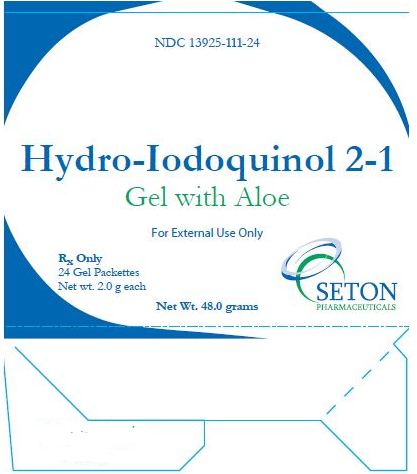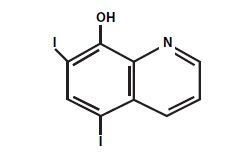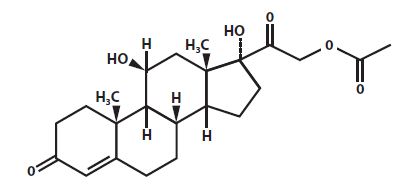HYDRO-IODOQUINOL
-
hydrocortisone acetate and
iodoquinol gel
Seton Pharmaceuticals
Disclaimer: This drug has not been found by FDA to be safe and effective, and this labeling has not been approved by FDA. For further information about unapproved drugs, click here.
----------
DESCRIPTION
Each gram of Hydro-Iodoquinol 2-1 Gel with Aloe contains 2.0% (20 mg) Hydrocortisone Acetate and 1.0% (10 mg) Iodoquinol. Also contains 1.0% (10 mg) Aloe polysaccharide. Other Ingredients: Amino Methylpropanol 95%, Benzyl Alcohol, Carbomer, Citric Acid Anhydrous, FD&C Blue #1, FD&C Yellow #10, Glycerin, Glyceryl Polymethacrylate, Magnesium Aluminum Silicate, Palmitoyl Oligopeptide, PPG-20 Methyl Glucose Ether, Propylene Glycol, Purified Water, and SD Alcohol 40B.
CLINICAL PHARMACOLOGY
Hydrocortisone Acetate has anti-inflammatory, antipruritic and vasoconstrictive properties. While the mechanism of anti-inflammatory activity is unclear, there is evidence to suggest that a recognizable correlation exists between vasoconstrictor potency and therapeutic efficacy in humans. Iodoquinol has both antifungal and antibacterial properties.
Pharmacokinetics
The extent of percutaneous absorption of topical steroids is determined by many factors including the vehicle, the integrity of the epidermal barrier and the use of occlusive dressings. Hydrocortisone acetate can be absorbed from normal intact skin. Inflammation and/or other inflammatory disease processes in the skin increase percutaneous absorption. Occlusive dressings substantially increase the percutaneous absorption of topical corticosteroids. Once absorbed through the skin, hydrocortisone acetate is metabolized in the liver and most body tissue to hydrogenated and degraded forms such as tetrahydrocortisone and tetrahydrocortisol. These are excreted in the urine, mainly conjugated as glucuronides, together with a very small proportion of unchanged hydrocortisone acetate. There is no data available regarding the percutaneous absorption of iodoquinol; however, following oral administration, 3-5% of the dose was recovered in the urine as a glucuronide.
INDICATIONS AND USAGE
Based on a review of a related drug by the National Research Council and subsequent FDA classification for that drug, the indications are as follows: "Possibly" Effective: Contact or atopic dermatitis; impetiginized eczema; nummular eczema; endogenous chronic infectious dermatitis; stasis dermatitis; pyoderma; nuchal eczema and chronic eczematoid otitis externa; acne urticata; localized or disseminated neurodermatitis; lichen simplex chronicus; anogenital pruritus (vulvae, scroti, ani); folliculitis; bacterial dermatoses; mycotic dermatoses such as tinea (capitis, cruris, corporis, pedis); monliasis; intertrigo. Final classification of the less-than-effective indications requires further investigation.
CONTRAINDICATIONS
Hydro-Iodoquinol 2-1 Gel with Aloe is contraindicated in those patients with a history of hypersensitivity to hydrocortisone acetate, iodoquinol, aloe vera, glycine, histidine, lysine, palmitic acid or any other components of the preparation.
WARNINGS AND PRECAUTIONS
For external use only. Keep away from eyes. If irritation develops, the use of Hydro-Iodoquinol 2-1 Gel with Aloe should be discontinued and appropriate therapy instituted. Staining of the skin, hair and fabrics may occur. Not intended for use on infants or under diapers or occlusive dressings. If extensive areas are treated or if the occlusive dressing technique is used, the possibility exists of increased systemic absorption of the corticosteroid, and suitable precautions should be taken. Children may absorb proportionally larger amounts of topical corticosteroids and thus be more susceptible to systemic toxicity. Parents of pediatric patients should be advised not to use tight-fitting diapers or plastic pants on a child being treated in the diaper area, as these garments may constitute occlusive dressings. Iodoquinol may be absorbed through the skin and interfere with thyroid function tests. If such tests are contemplated, wait at least one month after discontinuance of therapy to perform these tests. The ferric chloride test for phenylketonuria (PKU) can yield a false positive result if iodoquinol is present in the diaper or urine. Prolonged use may result in overgrowth of non-susceptible organisms requiring appropriate therapy. Keep out of reach of children. Burning, itching, irritation and dryness have been reported infrequently following the use of topical corticosteroids.
Carcinogenesis, Mutagenisis and Impairment of Fertility:
Long term animal studies have not been performed to evaluate the carcinogenic potential of the effect on fertility of hydrocortisone or iodoquinol. In vitro studies to determine mutagenicity with hydrocortisone have revealed negative results. Mutagenicity studies have not been performed with iodoquinol.
Pregnancy Category C:
Animal reproductive studies have not been conducted with Hydro-Iodoquinol 2-1 Gel with Aloe. It is not known whether Hydro-Iodoquinol 2-1 Gel with Aloe can cause fetal harm when administered to pregnant women or can affect reproductive capacity. Hydro-Iodoquinol 2-1 Gel with Aloe should be given to pregnant women only if clearly needed.
ADVERSE REACTIONS
The following local adverse reactions are reported infrequently with topical corticosteroids. These reactions are listed in an approximate decreasing order of occurrence. Burning, itching, irritation, dryness, folliculitis, hypertrichosis, acneiform eruptions, hypopigmentation, perioral dermatitis, allergic contact dermatitis, maceration of the skin, secondary infections, skin atrophy, striae and miliaria.
DOSAGE AND ADMINISTRATION
Apply to affected area 3-4 times daily in accordance with physician's directions or as directed otherwise by a physician.
HOW SUPPLIED
KEEP THIS AND ALL DRUGS OUT OF THE REACH OF CHILDREN.
Reserved for Professional Recommendation.
Call your doctor about side effects. You may report side effects to FDA at 1-800-FDA-1088.
All prescriptions using this product shall be pursuant to state statutes as applicable. This is not an Orange Book product. This product may be administered only under a physician’s supervision. There are no implied or explicit claims on therapeutic equivalence.
Rx Only
For External Use Only.
Manufactured For:
Seton Pharmaceuticals
Manasquan, NJ 08736
1-800-510-3401
07/10
SETON PHARMACEUTICALS
PRINCIPAL DISPLAY PANEL - 24 Pack Carton
NDC 13925-111-24
Hydro-Iodoquinol 2-1 Gel with Aloe
For External Use Only
Rx Only
24 Gel Packettes
Net wt. 2.0 g each
SETON PHARMACEUTICALS
Net Wt. 48.0 grams

| HYDRO-IODOQUINOL
hydrocortisone acetate, aloe vera leaf and iodoquinol gel |
||||||||||||||||||||||||||||||||
|
||||||||||||||||||||||||||||||||
|
||||||||||||||||||||||||||||||||
|
||||||||||||||||||||||||||||||||
|
||||||||||||||||||||||||||||||||
|
||||||||||||||||||||||||||||||||
| Marketing Information | |||
| Marketing Category | Application Number or Monograph Citation | Marketing Start Date | Marketing End Date |
| Unapproved drug other | 06/10/2010 | 10/02/2010 | |
| Labeler - Seton Pharmaceuticals (828898002) |
| Registrant - Seton Pharmaceuticals (828898002) |
| Establishment | |||
| Name | Address | ID/FEI | Operations |
| IGI Labs | 011036910 | MANUFACTURE | |
| Establishment | |||
| Name | Address | ID/FEI | Operations |
| Span Packaging | 557434805 | REPACK | |
Revised: 08/2012 Seton Pharmaceuticals

